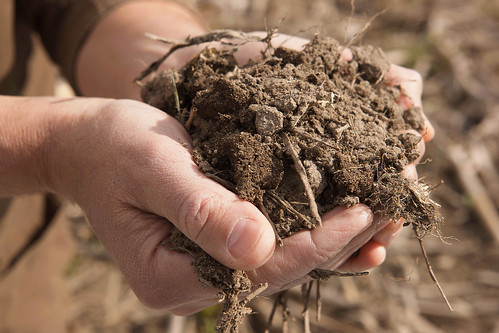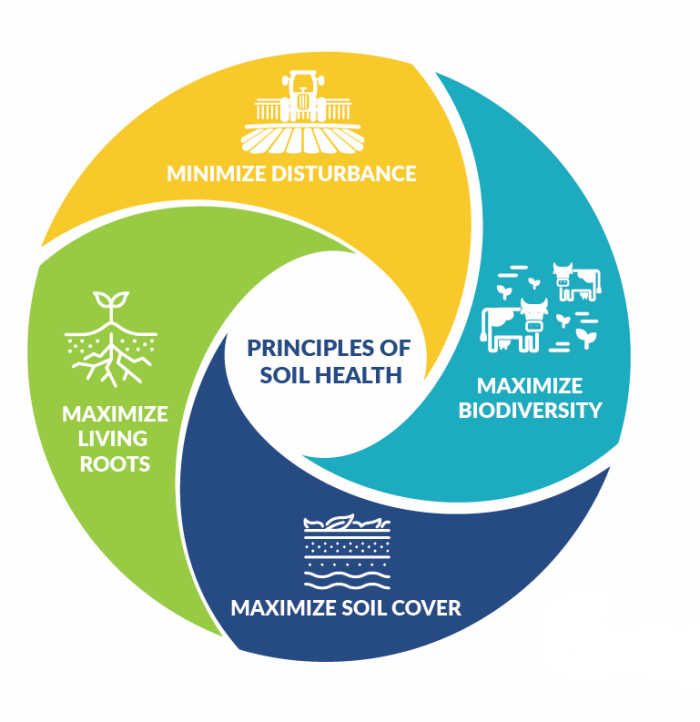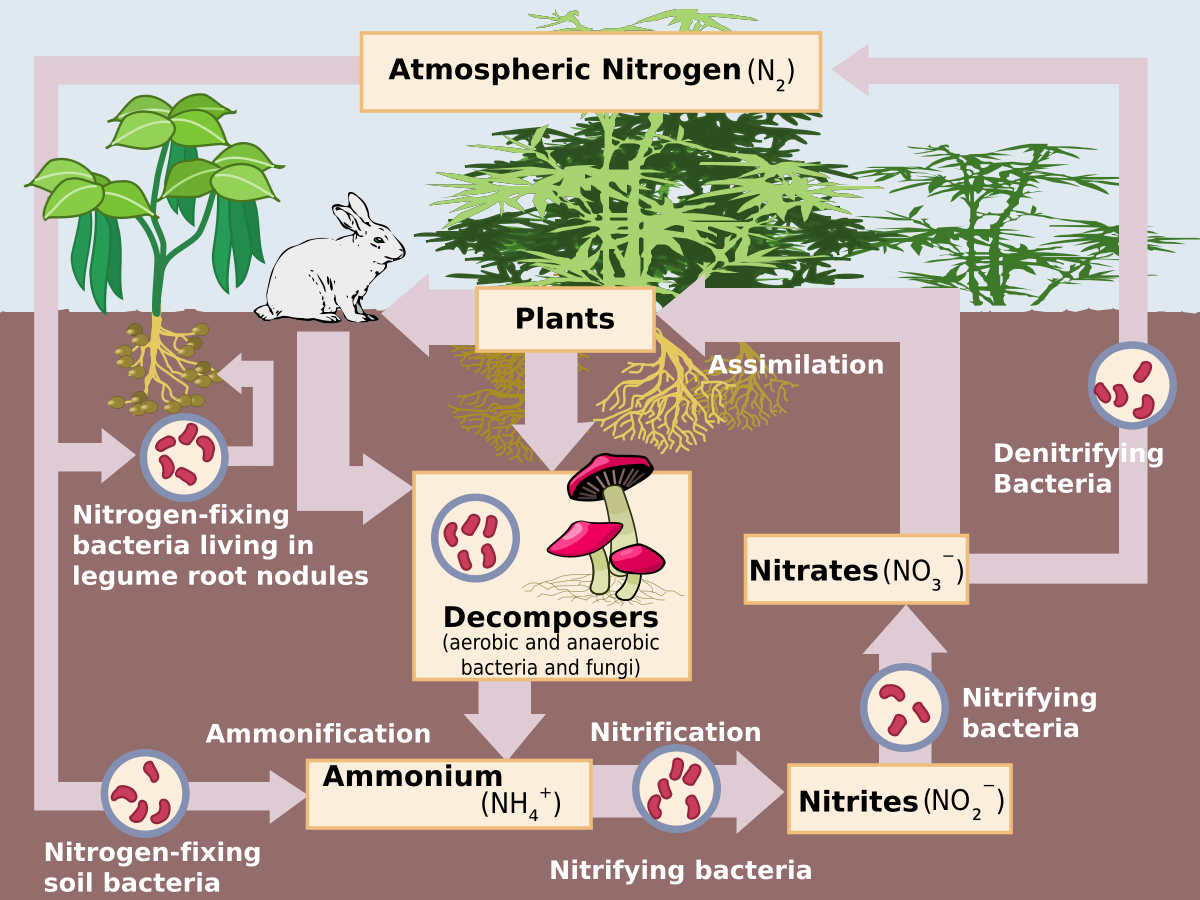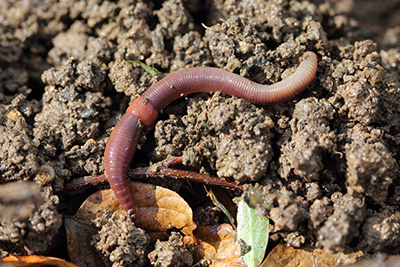Soil Health
What is Healthy Soil?
Healthy Soil is represented in many aspects, physical structure, chemical components and biological material. Soil structure should be loose enough to have spaces to allow water, air, and plant roots to enter the soil while also draining easily and holding enough moisture to maintain healthy plant growth. Healthy stable soil is gently held together by plant roots, microbes and organic material. Sufficient levels of essential nutrients like Nitrogen, Phosphorus, and Potassium are required for plant growth but lack of or excess nutrients can be a problem. Keep your soil healthy with a layer of organic matter which can improve the soils physical, chemical and biological health. Organic material (such as compost, mulch, leaves) also helps soils capacity to hold water, gradual release of nutrients, increases biodiversity and reduces the need for synthetic fertilizers.

Soil Health Resources and Databases
-
Soil Health - Natural Resources Conservation Service
- Web Soil Survey - US Dept. of Agriculture
- Soil Maps and Boundaries GIS data - NYS Museum
- Soils Resources - Food and Agriculture Org. of the UN
- Soil Health Institute
- U.S. Climate Resilience Toolkit
- The interdisciplinary nature of Soil - Article from EGU
-
Soil Resources for NYS - NRCS
- Unlock the Secrets in the Soil - Article from NRCS
- New York Soil Health
- Alternatives to Chemical Pesticides and Fertilizers - NYBG
- Urban Soils Institute.
- Urban Soils Information Sheet
- Contaminated Soils Information Sheet
Soil Fun Facts
- Soil makes up a remarkable thin layer of Earth's crust (Only about 25 miles deep, which is 1% of Earth's total mass). This thin layer is vital to human survival and contains all known life in the unverse.
- Simple tests can be preformed to indicate soil health. Look for the presence of earthworms or mycorrhizal fungi to indicate the overall health of the soil ecosystem.
- Soil purifies polluted water as it infiltrates into the ground. The biological, chemical, and physical filtering processes in a healthy soil protect the quality of drinking water in the aquefors below Long Island, filtering from heavy metals and chemicals.

Follow these Principles to maintain Soil Health. source: nrcs.gov
Soil Group Worksheets for Agricultural Assesments
The Nassau County Soil and Water Conservation District provides Soil Group Worksheets for Agricultural Assesments at the price of $50 per parcel. To apply for a soil group worksheet please contact dbetts@nassauswcd.org with your name, address, and a copy of your tax bill.
For more information about qualifying for Agricultural Tax credits, please call the NYS Dept. of Taxation and Finance hotline at 518-457-5149.
Interested in testing your soil at home or in the garden? NCSWCD will be hosting a soil testing event where Nassau County residents can recieve free testing on 1 - 3 saples. Next event date: August 18th, 2024
Major nutrients in the soil
Nitrogen (N)
Nitrogen is a key element in plant growth, it is found in all plant cells. Nitrogen makes up about 78% of earths atmosphere (N2). However most living things cannot use (N2) and rely on broken down nitrogen compounds such as nitrates (NO3) and nitrites (NO2). Some plants such as legumes can fix atmospheric nitrogen (N2) by converting it into ammonium compounds and then into (NO2)/(NO3) using bacteria that live in their roots, this process is called nitrogen fixation. Lastly, the bacteria break down nitrates releasing nitrogen gas back into the atmosphere through a process called denitrification.
Phosphorus (P)
Phosphorus helps plants with capturing, storing and converting the sun's energy into a form plants can use to preform photosynthesis. Phosphorus is a key component in plant cell division and is used in the development of the growing tip of the plant. Phosphorus can stimulate development of healthy roots, seeds and fruit. Phosphorus also contributes to disease resistance and increases the efficency of a plants water use.
Potassium (K)
Potassium aids in plant cell growth by activating enzymes called "hydrolases" which break down a cell wall's structural components, loosening the cell wall and allowing for expansion and growth. Potassium also helps move water, sugars and starches throughout the plant, which plays an important role in a plants overall yield and quality.
The Nutrient Cycle
Plants absorb nutrients
Plants take up nutrients from the soil and atmosphere. For example, plants absorb carbon dioxide from the atmosphere and convert it into glucose and other organic compounds through photosynthesis. These compounds are stored in the soil when plants and animals die and leave behind residue.
Microorganisms break down matter
Microorganisms in the soil, such as fungi and bacteria, break down organic matter and waste products from dead organisms. This process makes nutrients available again in mineral form so plants can use them. For example, nitrogen-fixing bacteria convert atmospheric nitrogen into ammonia, which nitrifying bacteria then convert into nitrate that plants can use.
Organisms consume nutrients
Animals and humans eat plants that have absorbed nutrients from the soil. When organisms die or excrete waste, nutrients are released back into the environment.

Click to enlarge

Life in the soil
Soil is not an inert, dead substance. A handful of healthy soil can contain more living organisms than human beings have ever lived on earth. According to researchers at OSU, a single gram of healthy garden soil can contain a billion bacteria, several yards of fungal hyphae, protozoa, and nematodes.
Fun Fact: The Northeast US does not have any native earthworms because glacial activity during the Pleistocene epoch covered the region with enough ice to eliminate all existing native earthworm populations. The earthworms currently found in Nassau County are introduced species from Europe and Asia through human activity.
